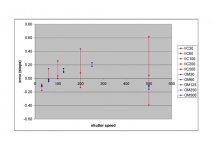As the curtains must begin moving from a standstill under the power of their springs, they have to accelerate, and this process continues as they traverse the gate.
Maintaining a constant slit width is fine, in theory, if the velocity of the curtains also remains constant.
Same slit width x same curtain velocity = same effective exposure.
Unfortunately because the curtain velocity increases, it's not that simple. Same slit width x increasing curtain velocity = decreasing exposure.
Hence, quality fp shutter designs must have a means of compensating for the curtain acceleration.
Designers know physics dictate that the curtains cannot instantly achieve ideal nominal velocity: mass, inertia etc. make this impossible. What they try to do, then, is to keep the
rate of acceleration more or less constant, because this makes compensating for it easier.
Compensation is achieved by setting up a commensurate increase in the slit width the closer the curtains get to the end of the gate. As a result, the product of the increasing curtain velocity and increasing slit width achieves consistent exposure across the gate, to within acceptable tolerances.
From the above it will be understood that, whilst the oft-used description of a typical 35mm fp shutter is that it operates at a constant curtain speed at constant slit width for each time setting, actually, this is a myth, since, in reality, both speed and slit vary unavoidably throughout the course of the exposure if acceptable accuracy is to be achieved.
There are several texts that delve into the principles of camera design but I think it is still hard to improve on J Lipinski's definitive discussion,
Miniature and Precision Cameras (Iliffe & Sons Ltd, 1955, 1956). Despite being long out of print, it’s highly recommended.
As it was the basis from which many other makes of fabric curtain focal plane shutter evolved, it's not surprising, then, that Lipinski covers the Barnack Leicas in some detail in the course of investigating the problems and solutions involved in designing a reliable, accurate, fp shutter. I quote, in part, from page 164 of my second edition, his comments about the Leica shutter:
“Uniformity of exposure will depend on the two blinds travelling at the same speed. Variation in blind velocity on acceleration is compensated for by the different diameters of the two drums, so that the slot opens up as the velocity increases.”
Regarding the thread starter’s dilemma of an increase in effective exposure towards the end of the film gate: The problem isn't that the first curtain is getting further away from the second as they cross the gate, because it’s actually meant to. The problem is that the rate of the increase of the slit width must obviously be
excessive.
There could be a few reasons for this. I'm generalising here, because I prefer the Contax (which has its own foibles, of course) and don't want much to do with Leica cameras, but some are as follows (this is not an exhaustive list).
- Change in dimensions of curtains or ribbons due to age/wear which can alter the relationship between the timing.
- Stiffened ribbons and/or curtain material not rolling/unrolling on/off the drums as smoothly as new, playing havoc with both curtain speed and acceleration rates.
- Need for servicing to ensure curtains are running at the proper speed and proper rate of acceleration, consistently.
- Spring fatigue necessitating adjustment of spindle tensions, to restore proper relationship between curtains.
- Mechanical wear, maladjustment, lack of cleanliness or lubricant deterioration connected to the second curtain latch or associated components, resulting in inappropriate delays in second curtain release.
Personally, having recently paid for the camera to be serviced, if you're unhappy with the accuracy of the shutter I think Chris's suggestion to discuss it with the person who worked on it in the first instance, is a good one.
Regards,
Brett


